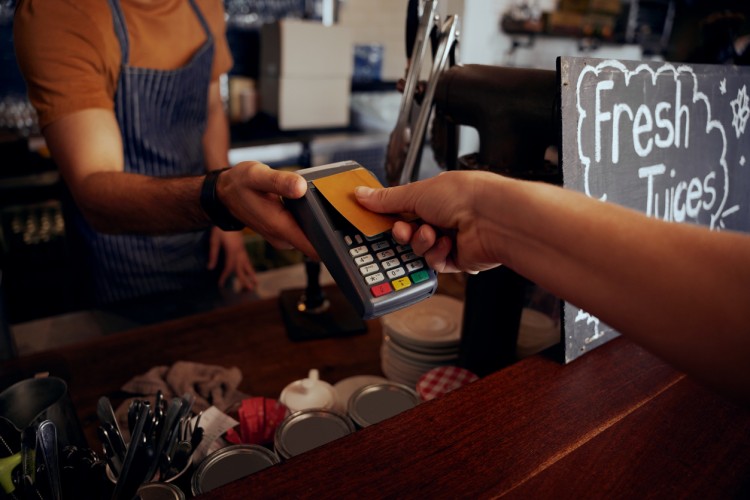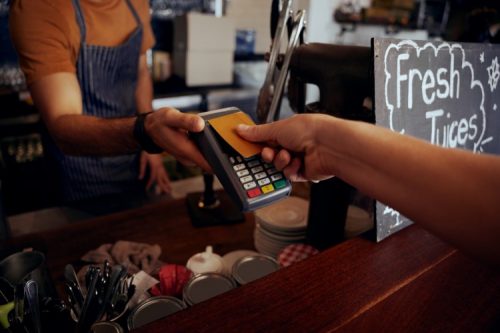Safeguard Your Next Contactless Card Payment and Mobile Purchase

Despite recent advancements in credit card safety protocols, such as temporary card verification value (CVV) numbers, chip cards, and contactless payments (which encrypt information for every transaction), consumers must continue to be diligent in safeguarding their information. Why? Because identity theft and credit card fraud are more prevalent than ever.

According to Define Financial, in 2020, the Federal Trade Commission received approximately 4.8 million reports of ID theft and credit card fraud, a 45% increase from 2019. In addition, “card not present” fraud (transactions conducted when the consumer isn’t physically present) is on the rise. A June 2021 Merchant Fraud Journal article estimates that chargebacks due to card not present fraud cost businesses roughly $40 billion per year.
Whether you use your credit cards to buy gas, groceries, or items online, there are ways you can keep your information safe.
Credit Card Fraud During the COVID-19 Pandemic
In a January 2021 interview with CNBC, an anti-money laundering practice research director at Aite Group estimated that, by the end of 2020, the U.S. saw roughly $11 billion in losses due to credit card fraud. The uptick in fraud reports, the article notes, is directly linked to the pandemic.
“What happens in every economic downturn is that the attacks start to become more successful,” warned Julie Fergerson, CEO of Merchant Risk Council, when speaking with CNBC reporters, adding that, over the next two to three years, she expects fraud reports will continue to rise.
Others believe that upticks in fraud reports are due to changes in consumers’ shopping habits. This is underscored by the results of a 2020 Experian survey, in which 33% of respondents said they increased their online shopping during the pandemic, and 52% of online shoppers said they were somewhat or extremely concerned that their bank or credit card information could be stolen when making online purchases.
What Contactless Card Payments Are, and Why They’re on the Rise
Contactless card payments, also known as tap-and-go payments, allow consumers to pay for goods and services in one of two ways: They can use a credit card that’s been added to their smartphone’s digital wallet, or a physical debit or credit card that’s equipped with radio-frequency identification (RFID) technology. If you have a card with a symbol that resembles a Wi-Fi logo tipped on its side, your card is equipped to make tap-and-go payments. This allows you to complete transactions simply by holding your card or phone next to the credit card terminal without entering a personal identification number (PIN).
Not surprisingly, the use of contactless card payments has spiked since the start of the pandemic.
In a May 2020 article published by Forbes, Mastercard CEO Ajay Banga said that Mastercard saw a 40% rise in the use of contactless payments in the first quarter of that year. The shift in payment methodology, he said, was being driven by “consumers who were looking for a quick way to get in and out of stores without exchanging cash, touching terminals or anything else.”
Are Contactless Card Payments Safe? Pros and Cons
Contactless payments are still relatively new, and many retailers, including national retail chains and mom-and-pop storefronts, lack the technology to accept them. Consumers also have questions about whether the technology is secure. Below are just a few of the pros and cons of tap-and-go payments.
- Pro: Tap-and-go payments are more secure than traditional transactions. Because cards aren’t inserted into a card reader, the likelihood of having a credit card number skimmed (i.e., having credit card data stolen by a physical card-skimming device) is greatly reduced.
- Pro: Transaction speeds are much faster. Instead of inserting a card and waiting for authorization, you literally tap and go: Payments are processed in less than a second.
- Con: Contactless payments aren’t yet widely accepted, especially among small independent retailers. If a retailer doesn’t have an upgraded credit card terminal that accepts tap-and-go payments, shoppers still need to insert their cards.
- Con: Transactions don’t require a PIN, so if a card is stolen, thieves can rack up thousands of dollars in charges in a short amount of time.
Tips to Protect Contactless Card Payments
Whether you’ve already migrated to contactless card payments or you’re thinking about doing so in the future, below are a few steps you can take to keep your information safe.
- Consider an RFID–blocking wallet. RFID-blocking wallets create an electromagnetic cage around your credit and debit cards. This protects users from electronic pickpocketing, a process by which credit card data is read remotely by a wireless device.
- Check your credit card and bank statements regularly. Monitor statements for fraudulent or unauthorized transactions. Thieves don’t always use stolen cards to make major purchases. In some instances, they may make several small purchases over a period of time.
- Set up transaction alerts for each of your cards. This will notify you via text or email each time a transaction is made.
- If you have credit card information stored in your phone’s digital wallet, make sure your phone is password protected. Be sure to set passwords for all devices that store financial information. Then, if they are lost or stolen, your sensitive data is still secure.
Keeping Your Information Safe
Credit card fraud happens every day, and if you’re among the hundreds of millions of Americans who prefer to pay with plastic, you need to be diligent when using credit cards and contactless payment methods. If you suspect your data may have been stolen, or you’ve found fraudulent or unauthorized activity on one or more of your accounts, block your cards and call your bank or financial institution immediately.
If you’re looking to be part of the solution, explore Maryville University’s online cybersecurity degree programs. Find out how you can help companies improve their security protocols and protect consumers in this increasingly risky environment.
Recommended Reading
Work from Home Safety Tips for Online Security
Is Procrastination Good or Bad? How Procrastinating Impacts Your Study Habits
How to Identify and Overcome Your Implicit Bias
Sources
CIO Outlook, Key Advantages and Disadvantages of Contactless Payment
CNBC, “Credit Card Fraud Will Increase Due to the Covid Pandemic, Experts Warn”
Define Financial, “Identity Theft and Credit Fraud Statistics 2021”
Experian, “Survey: The Impact of COVID-19 on Fraud and Identity Theft”
Forbes, “Contactless Payment Systems Are on the Rise as Pandemic Changes Consumer Habits”
Investopedia, “Contactless Payment”
Merchant Fraud Journal, “Card Not Present Fraud: How Companies Lose Nearly $10 Billion Per Year”
The Money Pages, “How to Protect Your Contactless Card and Digital Wallet from Criminals”

